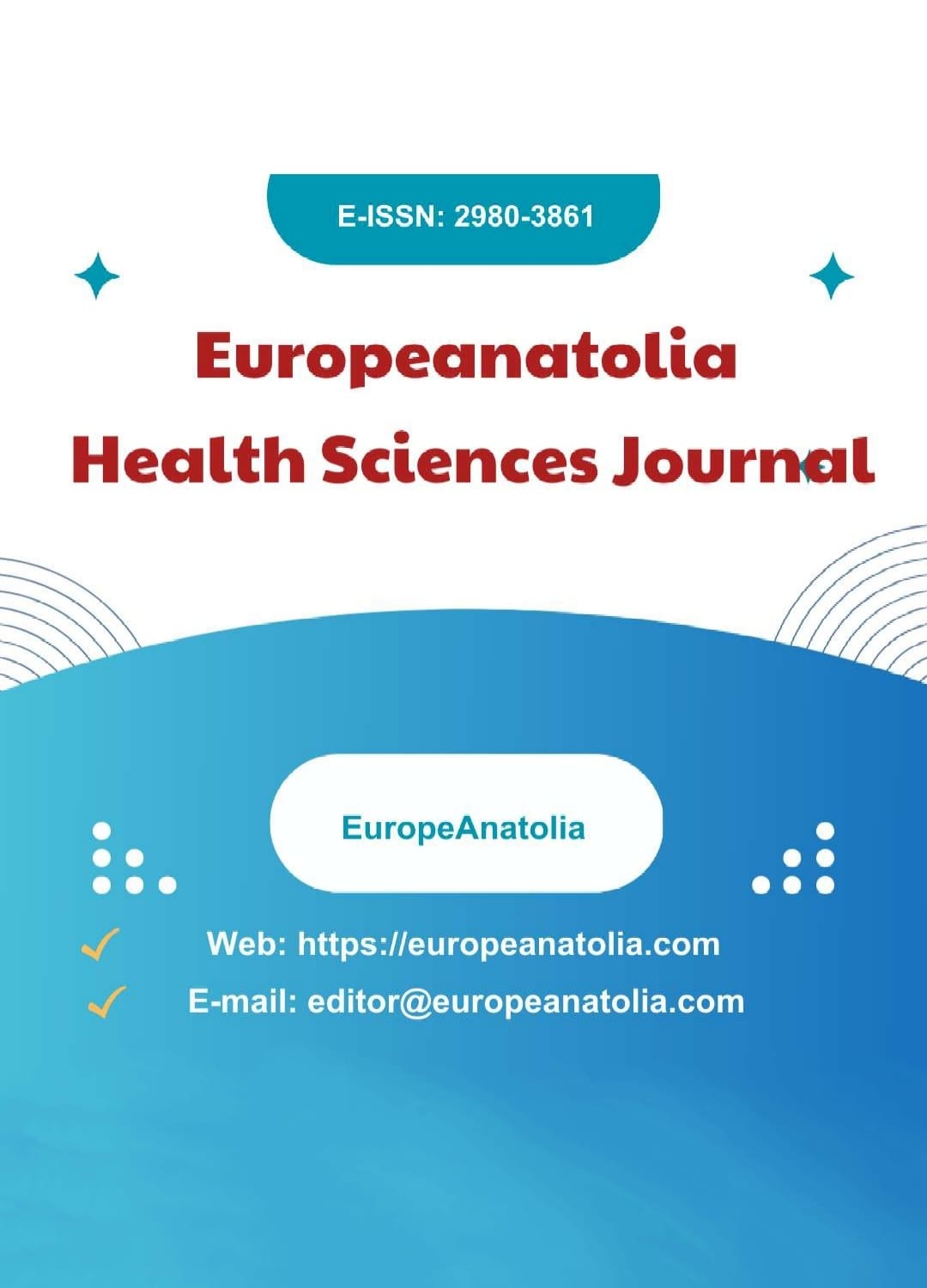Relationship Between Axillary Metastasis and Tumoral Response and Biomarkers in Breast Cancer Patients Who Received Neoadjuvant Chemotherapy
Research Article
DOI:
https://doi.org/10.5281/zenodo.14578208Keywords:
Breast Cancer, Neoadjuvant Chemotherapy, Tumor Subtype, Tumor Biology, Pathological ResponseAbstract
Introduction: The molecular subtype of the disease is related to the patient's clinical course, response to chemotherapy, and pathological response rates.
Objective: The molecular subtype of the disease is related to the patient's clinical course, response to chemotherapy, and pathological response rates. This research aimed to elucidate the relationship between neoadjuvant chemotherapy and treatment response in breast cancer patients who received neoadjuvant therapy and were evaluated with axillary lymph nodes after surgery.
Method: This retrospective analysis investigated the relationship between axillary metastasis status, tumoral and pathological complete response status, and molecular subtypes in 103 patients who received neoadjuvant chemotherapy for breast cancer and whose axillary lymph nodes were evaluated. Patients' age, menopause status, type of surgery, tumor side, axillary involvement, nodal involvement, T staging, histopathological type and subtypes, tumor receptors, perineural invasion, lymphovascular invasion, and tumor necrosis data were obtained from hospital records.
Results: A total of 103 female patients were included in the study. Histopathologically, the most common subtype was invasive ductal carcinoma (89.3%), and hormone receptor status was determined as ER-positive (73.8%) and PR positive (63.1%). Molecular subtypes were defined as Luminal B (36.9%) and Luminal A (34%), and the most common tumor grade was grade 2 (57.3%). The most common surgical method after neoadjuvant chemotherapy was radical mastectomy (97.1%). Among the cancer subgroups evaluated after neoadjuvant therapy, the most frequent subgroups with tumoral complete response were HER2 positive (47.4%), and triple-negative (45.5%) groups, the most frequent groups showing nodal complete response were HER2 positive (47.4%) and triple negative (63.6%) groups. The most frequent subgroups showing pathological complete response were HER2 positive (21.1%) and triple negative (36.4%) groups.
Conclusion: Breast cancer genetic subgroups are associated with treatment responses following neoadjuvant chemotherapy. Among breast cancer subgroups, the subgroups that provide the best tumoral, nodal, and pathological complete response to neoadjuvant chemotherapy are HER2-positive breast cancers and triple-negative breast cancer types.
References
Burstein HJ, Curigliano G, Thürlimann B, et al. Customizing local and systemic therapies for women with early breast cancer: the St. Gallen International Consensus Guidelines for treatment of early breast cancer 2021. Ann Oncol. 2021;32(10):1216-1235. doi:10.1016/j.annonc.2021.06.023
Luleci D, Kilic B. Factors Affecting Women's Participation in Breast Cancer Screening in Turkey. Asian Pac J Cancer Prev. 2022;23(5):1627-1634. Published 2022 May 1. doi:10.31557/APJCP.2022.23.5.1627
Ofri A, Elstner K, Mann GB, Kumar S, Warrier S. Neoadjuvant chemotherapy in non-metastatic breast cancer: The surgeon's perspective. Surgeon. 2023;21(6):356-360. doi:10.1016/j.surge.2023.04.001
Aldrich J, Canning M, Bhave M. Monitoring of Triple Negative Breast Cancer After Neoadjuvant Chemotherapy. Clin Breast Cancer. 2023;23(8):832-834. doi:10.1016/j.clbc.2023.08.001
Chaloupková Z, Coufal O, Gabrielová L. Current trends in breast cancer surgery. Aktuální trendy v chirurgii karcinomu prsu. Rozhl Chir. 2024;103(7):247-254. doi:10.48095/ccrvch2024247
von Minckwitz G, Untch M, Blohmer JU, et al. Definition and impact of pathologic complete response on prognosis after neoadjuvant chemotherapy in various intrinsic breast cancer subtypes. J Clin Oncol. 2012;30(15):1796-1804. doi:10.1200/JCO.2011.38.8595
Mamtani A, Barrio AV, King TA, et al. How Often Does Neoadjuvant Chemotherapy Avoid Axillary Dissection in Patients With Histologically Confirmed Nodal Metastases? Results of a Prospective Study. Ann Surg Oncol. 2016;23(11):3467-3474. doi:10.1245/s10434-016-5246-8
Collaborative Group on Hormonal Factors in Breast Cancer. Menarche, menopause, and breast cancer risk: individual participant meta-analysis, including 118 964 women with breast cancer from 117 epidemiological studies. Lancet Oncol. 2012;13(11):1141-1151. doi:10.1016/S1470-2045(12)70425-4
Colditz GA, Rosner B. Cumulative risk of breast cancer to age 70 years according to risk factor status: data from the Nurses' Health Study. Am J Epidemiol. 2000;152(10):950-964. doi:10.1093/aje/152.10.950
Gierach GL, Ichikawa L, Kerlikowske K, et al. Relationship between mammographic density and breast cancer death in the Breast Cancer Surveillance Consortium. J Natl Cancer Inst. 2012;104(16):1218-1227. doi:10.1093/jnci/djs327
Barrio AV, Mamtani A, Edelweiss M, et al. How Often Is Treatment Effect Identified in Axillary Nodes with a Pathologic Complete Response After Neoadjuvant Chemotherapy?. Ann Surg Oncol. 2016;23(11):3475-3480. doi:10.1245/s10434-016-5463-1
Mamounas EP, Anderson SJ, Dignam JJ, et al. Predictors of locoregional recurrence after neoadjuvant chemotherapy: results from combined analysis of National Surgical Adjuvant Breast and Bowel Project B-18 and B-27. J Clin Oncol. 2012;30(32):3960-3966. doi:10.1200/JCO.2011.40.8369
Parlakgumus A, Karakoc D, Ozenc A. Nine years' experience of needle localized breast biopsy in a university hospital: results and evaluation of the role of the surgeon in decision making. Acta Chir Belg. 2008;108(5):548-551. doi:10.1080/00015458.2008.11680283
Prat A, Pineda E, Adamo B, et al. Clinical implications of the intrinsic molecular subtypes of breast cancer. Breast. 2015;24 Suppl 2:S26-S35. doi:10.1016/j.breast.2015.07.008
Li CI, Uribe DJ, Daling JR. Clinical characteristics of different histologic types of breast cancer. Br J Cancer. 2005;93(9):1046-1052. doi:10.1038/sj.bjc.6602787
Loi S, Haibe-Kains B, Desmedt C, et al. Definition of clinically distinct molecular subtypes in estrogen receptor-positive breast carcinomas through genomic grade [published correction appears in J Clin Oncol. 2007 Aug 20;25(24):3790]. J Clin Oncol. 2007;25(10):1239-1246. doi:10.1200/JCO.2006.07.1522
Prat A, Chaudhury A, Solovieff N, et al. Correlative Biomarker Analysis of Intrinsic Subtypes and Efficacy Across the MONALEESA Phase III Studies [published correction appears in J Clin Oncol. 2021 Nov 1;39(31):3525. doi: 10.1200/JCO.21.02277] [published correction appears in J Clin Oncol. 2023 Apr 20;41(12):2299-2301. doi: 10.1200/JCO.23.00175]. J Clin Oncol. 2021;39(13):1458-1467. doi:10.1200/JCO.20.02977
Voduc KD, Cheang MC, Tyldesley S, Gelmon K, Nielsen TO, Kennecke H. Breast cancer subtypes and the risk of local and regional relapse. J Clin Oncol. 2010;28(10):1684-1691. doi:10.1200/JCO.2009.24.9284
Palmer JAV, Flippo-Morton T, Walsh KK, et al. Application of ACOSOG Z1071: Effect of Results on Patient Care and Surgical Decision-Making. Clin Breast Cancer. 2018;18(4):270-275. doi:10.1016/j.clbc.2017.10.006
Buzdar AU, Suman VJ, Meric-Bernstam F, et al. Fluorouracil, epirubicin, and cyclophosphamide (FEC-75) followed by paclitaxel plus trastuzumab versus paclitaxel plus trastuzumab followed by FEC-75 plus trastuzumab as neoadjuvant treatment for patients with HER2-positive breast cancer (Z1041): a randomised, controlled, phase 3 trial. Lancet Oncol. 2013;14(13):1317-1325. doi:10.1016/S1470-2045(13)70502-3
Kuehn T, Bauerfeind I, Fehm T, et al. Sentinel-lymph-node biopsy in patients with breast cancer before and after neoadjuvant chemotherapy (SENTINA): a prospective, multicentre cohort study. Lancet Oncol. 2013;14(7):609-618. doi:10.1016/S1470-2045(13)70166-9
de Azambuja E, Cardoso F, de Castro G Jr, et al. Ki-67 as prognostic marker in early breast cancer: a meta-analysis of published studies involving 12,155 patients. Br J Cancer. 2007;96(10):1504-1513. doi:10.1038/sj.bjc.6603756
Stuart-Harris R, Caldas C, Pinder SE, Pharoah P. Proliferation markers and survival in early breast cancer: a systematic review and meta-analysis of 85 studies in 32,825 patients. Breast. 2008;17(4):323-334. doi:10.1016/j.breast.2008.02.002
Boughey JC, McCall LM, Ballman KV, et al. Tumor biology correlates with rates of breast-conserving surgery and pathologic complete response after neoadjuvant chemotherapy for breast cancer: findings from the ACOSOG Z1071 (Alliance) Prospective Multicenter Clinical Trial. Ann Surg. 2014;260(4):608-616. doi:10.1097/SLA.0000000000000924
Caudle AS, Yu TK, Tucker SL, et al. Local-regional control according to surrogate markers of breast cancer subtypes and response to neoadjuvant chemotherapy in breast cancer patients undergoing breast-conserving therapy. Breast Cancer Res. 2012;14(3):R83. Published 2012 May 23. doi:10.1186/bcr3198
Bilani N, Elson L, Liang H, Elimimian EB, Nahleh Z. Effect of Surgery at Primary and Metastatic Sites in Patients With Stage IV Breast Cancer. Clin Breast Cancer. 2021;21(3):170-180. doi:10.1016/j.clbc.2020.08.008
Denlinger CS, Sanft T, Moslehi JJ, et al. NCCN Guidelines Insights: Survivorship, Version 2.2020. J Natl Compr Canc Netw. 2020;18(8):1016-1023. doi:10.6004/jnccn.2020.0037
Esserman LJ, Berry DA, Cheang MC, et al. Chemotherapy response and recurrence-free survival in neoadjuvant breast cancer depends on biomarker profiles: results from the I-SPY 1 TRIAL (CALGB 150007/150012; ACRIN 6657). Breast Cancer Res Treat. 2012;132(3):1049-1062. doi:10.1007/s10549-011-1895-2
Published
How to Cite
Issue
Section
License
Copyright (c) 2024 Europeanatolia Health Sciences Journal

This work is licensed under a Creative Commons Attribution 4.0 International License.











